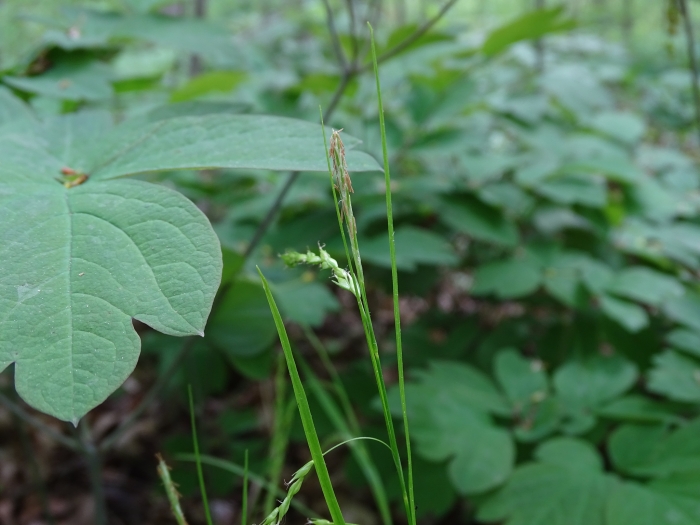Drooping Woodland Sedge
(Carex arctata)
Drooping Woodland Sedge (Carex arctata)
/
/

Reuven Martin
Public Domain
Image By:
Reuven Martin
Recorded By:
Copyright:
Public Domain
Copyright Notice:
Photo by: Reuven Martin | License Type: Public Domain | License URL: http://creativecommons.org/publicdomain/zero/1.0/ | Rights Holder: Reuven Martin | Publisher: iNaturalist | Date Created: 2019-05-24T12:44:40-07:00 |


















































Estimated Native Range
Summary
Carex arctata, commonly known as Drooping Woodland Sedge, is a semi-deciduous perennial grass native to the cool, moist, deciduous forests and the edges of marshes in the Northeastern USA and Canada. It typically grows to a height of 1-3 feet (0.3-0.9 meters) and a width of 0.8 feet (0.2 meters). This sedge forms clumps of arching, narrow, grass-like leaves, which may take on a bronze hue in fall. It is not particularly showy, but its fine-textured foliage adds a delicate, woodland aesthetic to garden settings.
Drooping Woodland Sedge is valued for its ability to thrive in shaded conditions and its adaptability to a range of soil moisture levels, making it an excellent ground cover for woodland gardens and shaded borders. It is also used for erosion control on shaded slopes. While it prefers consistently moist soils, it can tolerate periods of dryness once established. It is best grown in part shade but can tolerate full shade. This sedge is relatively low-maintenance, but it may require division every few years to maintain vigor. It is not commonly afflicted by serious pests or diseases.CC BY-SA 4.0
Drooping Woodland Sedge is valued for its ability to thrive in shaded conditions and its adaptability to a range of soil moisture levels, making it an excellent ground cover for woodland gardens and shaded borders. It is also used for erosion control on shaded slopes. While it prefers consistently moist soils, it can tolerate periods of dryness once established. It is best grown in part shade but can tolerate full shade. This sedge is relatively low-maintenance, but it may require division every few years to maintain vigor. It is not commonly afflicted by serious pests or diseases.CC BY-SA 4.0
Plant Description
- Plant Type: Grass
- Height: 1-3 feet
- Width: 0.267-0.8 feet
- Growth Rate: Rapid
- Flower Color: N/A
- Flowering Season: Summer
- Leaf Retention: Semi-Deciduous
Growth Requirements
- Sun: Part Shade
- Water: Medium, High
- Drainage: Medium
Common Uses
Bird Garden, Deer Resistant, Low Maintenance, Water Garden
Natural Habitat
Cool, moist, deciduous forests and the edges of marshes
Other Names
Common Names: Black Sedge, Compressed Sedge, Drooping Wood Sedge, Carex Comprimé
Scientific Names: , Carex arctata, Carex arctata var. faxonii,
GBIF Accepted Name: Carex arctata Boott